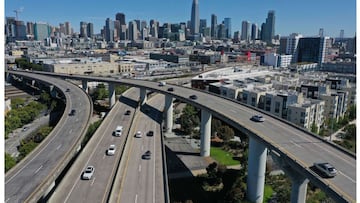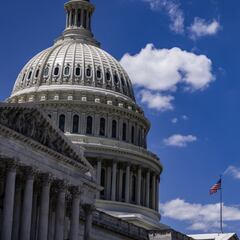How does the bipartisan infrastructure bill compare to Biden's American Jobs Plan?
New info has become available on what will be included in the bipartisan infrastructure bill which is gaining support in the Senate. How does it compare to Biden’s plan?


Last week, Senator Susan Collins of Maine announced that she and ten other Democratic and Republican senators had reached an agreement on a bipartisan infrastructure proposal. Since the announcement, details have begun to be leaked, released, and reported. The announcement on a deal between members of both parties came after negotiations between the White House and top Republicans collapsed over the President’s own proposal.
This week, support for the plan has grown in the Senate, with more than twenty-one Senators, split between Republicans and Democrats, signing onto the bill. The proposal, which serves as a counter to the President’s 2.3 trillion dollar American Jobs Plan, is around half the size and focuses spending primarily on physical infrastructure.
What does the emerging package contain?
Based on a factsheet released by the group of Senators, and published by Politico, the total value of the package is $579 billion. The major investments in transportation infrastructure covered in the initial draft include,
- $110 billion for roads, bridges, and “major projects,”
- $66 billion for passenger and freight rail,
- $48.5 billion for public transportation systems, and
- $88 billion for other transport-based physical infrastructure.
WATCH: 21 moderate senators support a new bipartisan infrastructure deal, but it is unclear if they can get their colleagues on board. #MTPDaily @Kasie: "There's a lot, I think, of back and forth and politicking to be done here before we see the end of this tunnel." pic.twitter.com/MjxXwmO9MJ
— Meet the Press (@MeetThePress) June 17, 2021
As far as other types of infrastructure are concerned, the plan would allocate more than $266 billion to improve power, broadband, and water infrastructure.
How does this compare to the American Families Plan?
The investments proposed in the plan are not so different from those put forward by President Biden.
The main difference is in price and the fact that the Senate proposal does not include any funding for what the President has referred to as "social infrastructure." The social investments include improving the working conditions and wages of workers involved in the care economy and more.
Infrastructure Type/Area |
American Jobs Plan (Billions) |
Senate Plan (Billions) |
Transportation Infrastructure | ||
Highways, bridges, roads | $115 | $110 |
Public transit | $85 | $48.5 |
Rail | $80 | $66 |
Electric vehicles | $174 | $15 |
Airports, ports, and waterways | $42 | $41.3 |
Transportation inequities, safety, reconnecting communities | $45 | $12 |
Total |
$541 |
$293 |
Community/Other Infrastructure | ||
Clean drinking water | $111 | $60 |
Broadband | $100 | $65 |
Electric | $100 | $73 |
Housing | $213 | $0 |
Schools and VA hospitals | $137 | $0 |
Other misc. programs | $28 | $21 |
Resiliency | $50 | $47.2 |
Total |
$739 |
$266.2 |
Plan Total |
$1,260 |
$559 |
Data:Holland & Knight's Public Policy & Regulation Group, Investopedia, and Senate Factsheet
When comparing the two proposals based on their investments in physical infrastructure, that main difference is price. For each of the various areas, the American Families Plan has a higher price tag.
With the information available as of 17 June, a 721 billion dollar gap can be identified as far as physical infrastructure is concerned. The gap is motivated primarily by the lack of funding for public housing, schools, and Veterans Affairs hospitals in the new Senate proposal.
Areas where the largest gaps exist include rail and freight infrastructure, where the President proposed $66 billion more than the group of Senators. The differences between the proposals related to clean water and broadband access also totaled more than $60 billion.
Funding
One of the promises made by then-candidate Biden on the campaign trail was that he would not increases taxes on anyone making less than $400,000 a year. In order to pay for his plan, Biden has proposed an increase in the corporate tax rate. In the factsheet on the American Jobs Plan released by the White House, the team argued that this increase was justified because the 2017 tax law passed under Trump, which lowered the corporate tax rate to twenty-one percent, “made an unfair system worse.”
Citing a recent study that showed the little taxes paid by some of the US’ most profitable corporations, the White House argues that “Biden’s reform will reverse this damage and fundamentally reform the way the tax code treats the largest corporations. from twenty-one to twenty-seven percent, which would still be a lower rate than what it was before the passage of the Trump tax bill in 2017.”
Republicans, and even some more conservative Democrats, oppose increasing the corporate tax rate to those levels, let alone at all. Instead, they have vowed to keep the tax rate for corporations the same and have proposed a few other funding mechanisms to finance the plan.
These include the establishment of an Infrastructure Financing Authority, which would attract and "leverage private investment." The proposal allocates nearly $20 billion dollars to get the organization off the ground. Another key source of funding is the repurposing of unused covid-19 and unemployment insurance relief funds.
Additionally, the information sheet released by the group includes “Public-private partnerships, Private Activity Bonds, and asset recycling.” Asset recycling is the process by which an asset is leased to the private sector, wherein they take ownership and are tasked with increasing revenue. In the transportation sphere, this usually takes the form of tolls which are implemented on roads, which later are then used to make improvements.
However, critics say that companies, as profit-motivated entities, have far too much power to set prices and can create a burden on lower-income families who have to use roadways to get to work or drive their children to school.
Related stories
One of the most controversial funding options includes an “annual surcharge on Electric Vehicles.” Climate-focused lawmakers see this proposition as a non-starter, and a way to unnecessarily penalize those who opt to buy greener cars.
However, Susan Collins of Maine, argues that electric vehicle drivers are “free-riders” because they do not pay gas taxes which often go towards the funding of infrastructure projects. However, while they do not pay gas taxes, they are more likely to have higher electric bills, which could mean the government is double charging them while letting polluters off the hook.
- Infrastructures policy
- Senate members
- Covid-19 economic crisis
- Senate
- Science
- Coronavirus Covid-19
- Economic crisis
- United States
- Pandemic
- Coronavirus
- Recession
- Economic climate
- Virology
- Outbreak
- Infectious diseases
- North America
- Parliament
- Diseases
- Microbiology
- Public works
- Medicine
- America
- Economy
- Urbanism
- Biology
- Health
- Politics
- Life sciences

